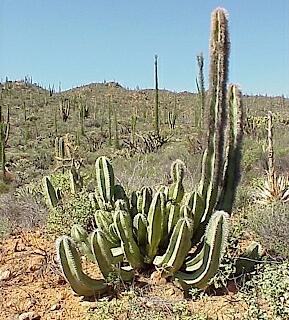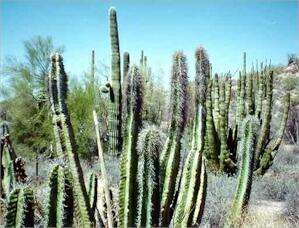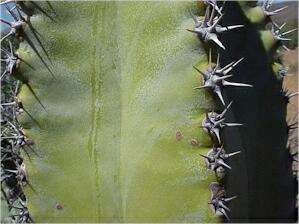SENITA - OLD MAN CACTUS
(Lophocereus schottii)
The old man cactus (senita) can grow on rocky hillsides but grows mainly on dry alluvial plains in the desert regions of mainland Mexico and the Baja California peninsula of Mexico (where this photograph was taken). Small populations also occur in the extreme south of Arizona, but its northern limit is dictated by frosts that can occur on the flat sites where it grows. It is a large columnar cactus, branching at the base, and can reach a height of 3-4 metres. It has relatively few (5-8) widely-spaced ribs. One of the most distinguishing features is that the tips of the mature, taller stems are covered with long, hairlike, grey spines.
In contrast to the long spines at the tips of mature stems, the juvenile stems of senita have only short, stiff clusters of spines (see close-up above). This photograph also shows the waxy bloom on the surface of the stem. Senita has recently been found to have a mutualistic association with a moth, which pollinates the small flowers and lays its eggs in them so that the larvae can develop by feeding on the fruit tissues. This relationship closely resembles the widely known example of moth pollination of yucca species. Mutant growth forms Cacti occasionally show abnormal growth forms - called "monstrose" forms, uncharacteristic of the species. An interesting example of this is shown below, where the senita cactus has a genetically stable variant form. Instead of the ribbed stems of a normal senita, these plants have raised tubercle-like swellings along the stems, and few (if any) spines. This growth form of senita is sterile and yet, interestingly, it occurs naturally in at least two wild populations in Baja California. In these two locations the plants persist because stem sections break off periodically and root to produce new plants.
Other examples of monstrose growth forms can occur in the Saguaro and the Cardon cactus. GO TO: |




